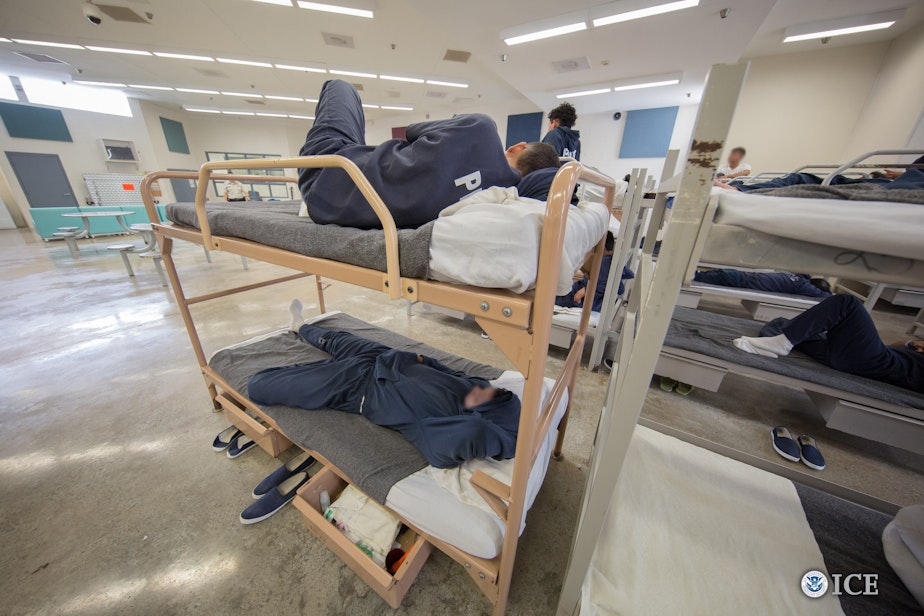Hunger strike at Tacoma detention center? ICE and advocates disagree

Immigrant advocates say more than 25 women joined a hunger strike this weekend at the Northwest Detention Center in Tacoma. This follows reports of similar protests at the immigration lockup in April.
The detainees are reportedly demanding better food and medical care, as well as fewer delays in their court cases.
This week, immigrant advocates sent out recorded comments from a woman who’s been held at the facility three months.
“They’re treating us like we’re animals” said Alma, who was only identified by her first name. “Every day we’re doing worse than the day before.”
Alma said she’s refused meals since May 4 because the smell of the food makes her feel sick. Yes she is buying some food at the commissary, which she says is expensive.
Sponsored
Alma also cited concerns with medical staff, saying it took paramedics 20 minutes to respond to a woman passed out on the floor. She said complaints to ICE go unanswered.
Rose Riley, a spokeswoman with the Seattle office of U.S. Immigration and Customs Enforcement, said current reports of a hunger strike are untrue.
“There is no indication of organized meal refusals at the Northwest Detention Center and no detainee has verbalized an intent to do so,” Riley wrote in an email to KUOW.
Riley said facility staff are monitoring the situation and take health issues seriously.
In April, advocates also claimed up to 750 detainees joined a hunger strike to protest conditions at the Tacoma lockup, and facility staff retaliated against hunger strikers by moving them to a lockup in Oregon.
Sponsored
ICE officials refute that and say only one detainee in Tacoma was considered on hunger strike in April after not eating anything for 72 hours. ICE also says staff met with detainees in April about changes to the menu and other concerns.
Clearly, immigrant advocates and ICE officials disagree about the definition of a hunger strike. KUOW recently asked ICE to clarify its policy and provide more details about the reported, ongoing hunger strikes in April. Here is the response from ICE spokeswoman Rose Riley on May 5, 2017.
KUOW: How are you tracking if detainees at the Northwest Detention Center refuse meals or state they are on a hunger strike?
ICE: The Northwest Detention Center staff monitors meals served during the regularly scheduled breakfast, lunch and dinner schedule. If detainees verbalize an intent to hunger strike, staff will open communication with them to determine whether they continue to eat commissary items or if they have stopped eating all together.
If a detainee affirmatively responds with intent to hunger strike, they are transferred to a dedicated housing unit to be closely monitored to ensure their welfare. There is no current indication of organized or continuous meal refusals at the Northwest Detention Center.
Sponsored
KUOW: What is the protocol when detainees refuse meals consecutive days?
ICE: The facility’s staff communicates with those detainees who refuse consecutive meals to determine if they intend to continue refusing meals. Those who respond affirmatively are transferred to a dedicated housing unit so they can be closely monitored to ensure their welfare. For those individuals, ICE will implement the hunger strike protocols (Word doc), which includes close medical supervision and suspension of commissary privileges. All detainees who are engaged in a hunger strike will continue to be offered three meals daily and provided an adequate supply of drinking water or other beverages.
KUOW: Can you provide a headcount of NWDC detainees who’ve refused meals on any dates in April and May?
ICE: Every day low numbers of detainees choose not to eat meals provided by the cafeteria for various reasons. A head count on any particular day would not provide context behind whether certain detainees have refused consecutive meals. If a detainee verbalizes an intent to hunger strike, facility staff begins to closely monitor food intake to determine whether consecutive meals have been refused. Only after an individual is observed not to have eaten at all for 72 hours will they be considered on hunger strike and at that point become subject to the agency’s protocols for handling hunger strikes.
KUOW: Has ICE/GEO met with detainees reportedly on hunger strike to discuss their demands or grievances? (GEO Group is a private contractor that manages the Northwest Detention Center)
Sponsored
ICE: Following the recent consecutive meal refusals in April by some detainees at the Northwest Detention Center, U.S. Immigration and Customs Enforcement and The GEO group offered a sampling of regularly served meal menus for detainees to vote on for the upcoming six-week meal cycle. Staff is adjusting the menu based on the outcome of the vote and will implement the new menu in the next two weeks.
KUOW: Immigrant advocates say up to 750 detainees at the Northwest Detention Center refused meals for a week, starting April 10. How many individuals at NWDC were under hunger strike protocols in April?
ICE: Several detainees refused meals on separate occasions in April, however, only one detainee refused nine consecutive regularly served meals, meeting the official ICE definition of being on hunger strike. Facility staff closely monitored the individual after determining there was an intent to refuse consecutive meals and commissary items. Medical staff discussed health risks while offering an adequate supply of drinking water and other beverages. The detainee resumed eating regularly served meals immediately following the ninth missed meal. As of Tuesday, all detainees have resumed eating regularly scheduled meals.

